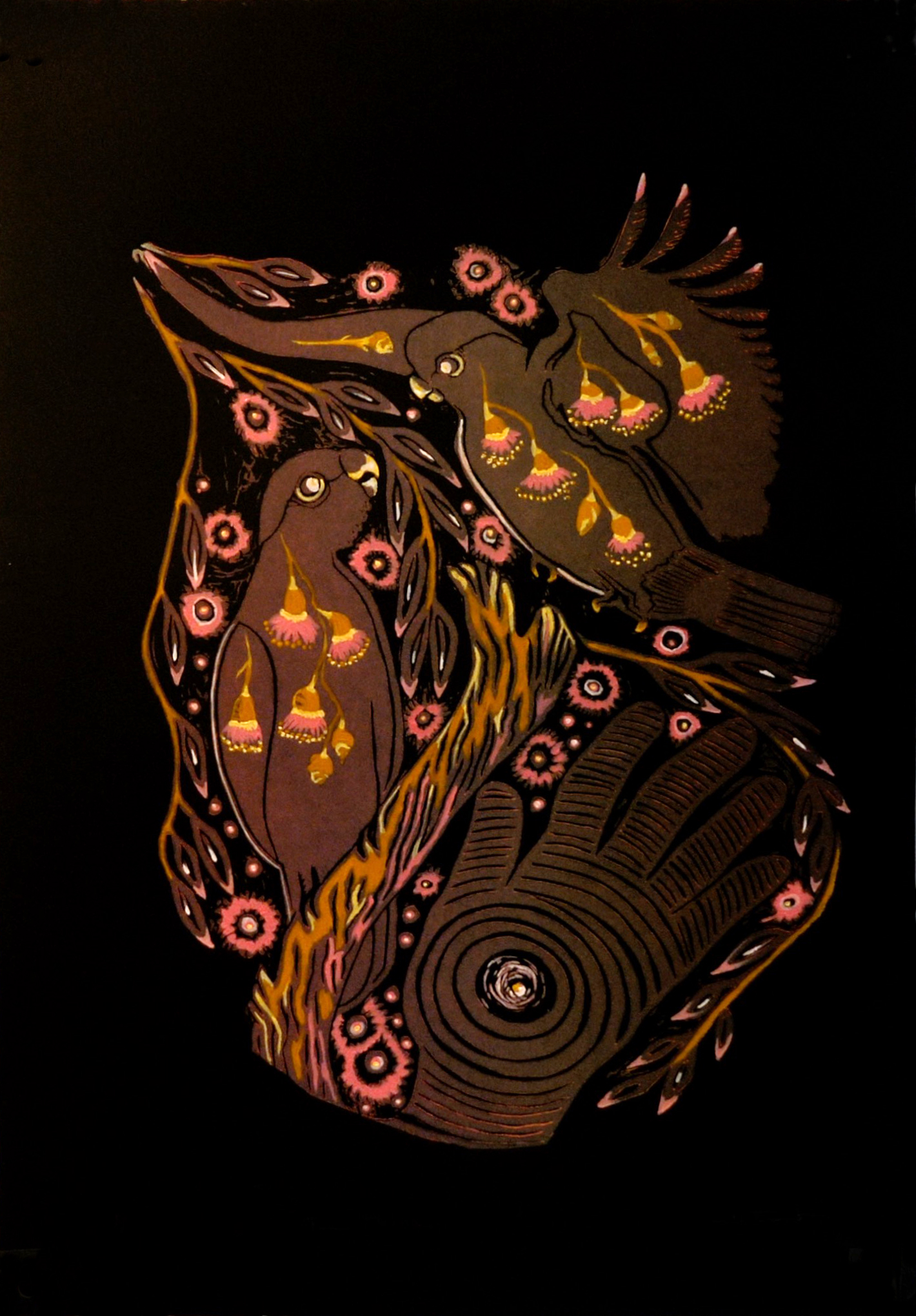



From top:
Heather Tait, The Perch, 2021, vinylcut and mixed media, 56 x 38 cm
Kay Wiliams, Pandanus and Dilly Bag I, 2021, monotype, 49 x 37 cm
Sheryl Burchill, Illusion, 2021, monotype, 53 x 37 cm
Ruth Saveka, Wongai Season, 2021, monotype, 37 x 50 cm
Kassandra Savage, Feasting on Country, 2021, monotype, 44 x 55 cm
Q: How was the Upside Up program developed and what special considerations were at work? How did the project develop in terms of its content/theme?
A: Upside Up was conceived as a capacity-building program for emerging Indigenous artists in the Cairns region. InkMasters Cairns successfully applied to the Australian Government’s Regional Arts ‘Recovery’ Fund and was able to provide valuable studio access time, materials and mentoring by established printmaking artists. Three mentors – Hannah Parker, Theo Tremblay and Justin Majid – engaged with ten artists, one day a week for thirty-four weeks. Participating artists were guided in making drypoint, etching, vinylcut, stone lithography, screenprint and monotype prints. With the support of NorthSite Contemporary Arts from the outset, the artists were also nurtured towards the preparation of a public exhibition of their work. Thematic interests were entirely the artists’ own.
Q: What were some of the pathways involved in getting people engaged and producing work? Were there various levels of previous exposure to printmaking and a variety of technical and thematic interests?
A: All of the artists who became involved with the Upside Up program had some printmaking experience at a post-secondary level, but like many other graduates from TAFE and university courses (especially in regional areas), they did not have ready access to making space and facilities. They also lacked connections to mentors who could help expand their range of skills or foster their careers as visual artists. InkMasters recognised this need in a new generation of Indigenous artists in particular, though printmaking has traditionally been a strength in this region.
A call-out was issued, artists approached us and were inducted into the program. Some took leave from paid employment, travelled long distances or made other arrangements to enable them to attend and benefit from the program. The artists who presented work for the exhibition at NorthSite worked enthusiastically, and with the great spirit of camaraderie that a good community printmaking workshop can generate. Critique of the works and discussions about content, form and possible new directions took place in this context.
Q: How does the work manifest as an exhibition? What are some of the works?
A: Heather Tait, Kassandra Savage, Kay Williams, Sheryl J. Burchill and Ruth Saveka in particular created extensive bodies of work that they presented for curatorial selection. The works, while in each instance connecting with the Indigenous heritage of their makers, are also fresh, spontaneous and reflective of the artists’ individual aesthetic visions. They are also beautifully crafted.
Heather Tait includes references to the place in which she was born (the Kimberley area’s boab trees, native birds and Bungle Bungle landscape) but infuses her imagery with surreal imaginings. Kay Williams depicts pared-back versions of dilly-bags and the pandanus trees from which she collects leaves and weaves baskets. Dragon flies (Wurarr-wurarr in the Kuku Yalanji language) are a recurring motif in Sheryl J. Burchill’s prints, and she skilfully represents their fragility across different print media. Ruth Saveka, with a strong designer’s eye, portrays fruits and plants such as the Wongai plum (Manilkara zapota) from her recollections of a childhood in the Torres Strait Islands and Cairns. Crustaceans, fish, native birds and and the fun of fishing with family feature prominently in Kassandra Savage’s prints, where overlapping forms and textures are boldly combined.
The Upside Up exhibition at NorthSite Contemporary Arts allows each artist’s prints the space to articulate their personal voice. The installation as a whole, however, presents a coherent display of shared interests in image-making and an exuberant delight in the materials and processes of print media. The works are all refreshingly candid and indeed good-humoured – speaking in an unaffected way, free of political or other posturing, about the lived experiences of the artists.
Q: What is it about the printmaking experience that participants seemed to be most interested in?
A: The Upside Up artists all had some (albeit limited) experience of printmaking from their formal studies, and so had an idea of the potential of print media to extend their respective practices. They had seen the work of successful Indigenous printmaking artists and thus had some appreciation of the possibilities of making editions and presenting their work in multiple venues. Once involved in the project, working with their mentors and with quality materials, they discovered the joy of the unexpected – the surprises (as well as occasional frustrations) that occur when working with the material properties of ink on paper. What emerged for the artists, foremost, was delight in image-making through their growing confidence in the handling of print processes. The presentation of a small selection of the works created in a prestigious exhibition space, and a positive response from the art-loving public, will undoubtedly bolster that confidence!
—
YouTube video about the Upside Up project and exhibition can be viewed here: https://www.youtube.com/watch?v=DeRF0fm4Ioo&t=13s
Upside Up is at NorthSite Contemporary Arts, Bulmba-ja Arts Centre, 96 Abbott Street, Cairns, from 2 November 2021 to 29 January 2022
—
Join the PCA and become a member. You’ll get the fine-art quarterly print magazine Imprint, free promotion of your exhibitions, discounts on art materials and a range of other exclusive benefits.





